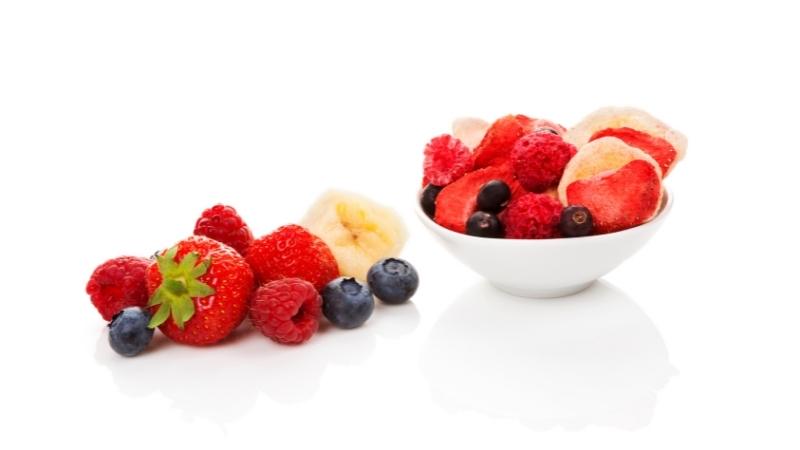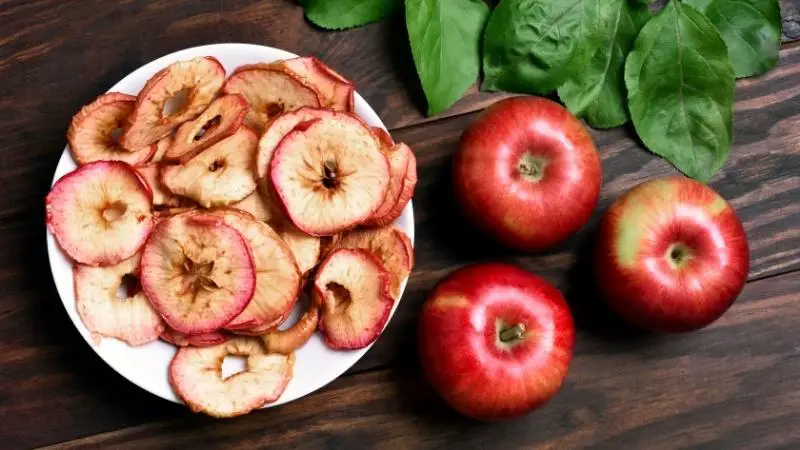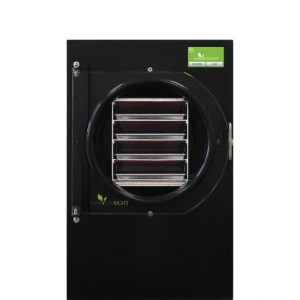I enjoy preserving foods and have often desired to do a full comparison between a freeze dryer vs dehydrator. I do own both a freeze dryer and a food dehydrator, and spend time freeze-drying and dehydrating a variety of foods for food storage, emergencies, camping, backpacking, snacks, and more.
Both freeze-drying and dehydrating are food preservation methods that involve removing water from foods giving them a much longer shelf life. Over the years I’ve compared freeze-drying with dehydrating. What are the differences between freeze-dried food and dehydrated food?
The main differences between freeze-drying and dehydrating food are cost, nutritional value, shelf-life, amount of water/moisture removal, rehydration time/process, food texture/shape, food flavor, and individual preference.
Freeze-Drying Process
Freeze-drying is a process of removing moisture from the food by freezing it and then drying it in a vacuum. This process removes 98% of the water content from the food, which helps in preserving the nutritional value and flavor (PSU Extension). Freeze-dried foods have a longer shelf life than dehydrated foods, and they also retain their original shape and texture.
Benefits of Freeze-Dried Foods
Freeze-dried foods are a popular choice among preppers and backpackers for several reasons. They have a long shelf life, which makes them an excellent option for emergency food storage. Here are some benefits of freeze-dried foods:
- Lightweight and easy to store
- Retains nutritional value and flavor
- Has a longer shelf life than dehydrated foods
- Quick and easy to prepare
Dehydrated Foods Process
Dehydrated foods are preserved by removing the water content from the food. The food is heated to remove the moisture, and the remaining food is stored for future use (MU Extension).
Benefits of Dehydrated Foods
Dehydrated foods are a popular option for long-term food storage due to their long shelf life and light weight. Here are some benefits of dehydrated foods:
- Lightweight and easy to store
- Has a longer shelf life than fresh foods
- Retains nutritional value and flavor
The 9 main differences between freeze-drying food and dehydrating food include:
| Differences | Freeze Drying | Dehydrating |
|---|---|---|
| Retail Food Cost | More Expensive | Less Expensive |
| Machine Cost | $2,595 – $3,595 | $40 – $300 |
| Nutritional Value | Retains 97% | Retains 60% |
| Shelf-life | 15 – 25 Years | 5 – 10 Years (longer in some cases) |
| Amount of Water/Moisture Removal | 98 – 99% moisture removal | 80 – 90% moisture removal |
| Rehydration Time | Rehydrates in 5 minutes or less | Rehydrates in 10 – 20 minutes (varies) |
| Food Texture/Shape | Maintains a similar texture and shape | Become more shrunken and wrinkled |
| Food Flavor | Maintains a similar flavor but without moisture | Flavor changes more due to higher heat being used |
If you’re interested in freeze drying or dehydrating your own food check out our articles Buying a Home Freeze Dryer, What You Need to Know First and Selecting the Best Food Dehydrator, Ultimate Buyers Guide.
Also, It’s important to see How to store freeze dried food and its shelf life, What foods you can and cannot freeze dry, and What foods you can and cannot dehydrate.
1. Nutritional Value
Both freeze-dried and dehydrated foods can be healthy options. However, freeze-dried food is healthier (maintains a higher nutritional value) than dehydrated food if done and stored properly. The freeze-drying process freezes foods, creates a vacuum around the food, and then slowly warms the food causing sublimation to occur which removes the frozen water directly from a solid to a gas skipping the liquid phase. The dehydration process requires a higher heat to dry foods which damages more nutrients in the food than freeze drying.
Freeze-drying food retains about 97% of the nutritional value that the food item had before being freeze-dried. It’s important to note that although it maintains a high nutritional value after being freeze-dried it is critical that it is stored properly in a cool, dark place that is free of oxygen or it will lose nutrients quickly while being stored.

Dehydrated food retains about 60% of its original nutritional value on average. However, it depends on how high heat is used when dehydrating your food. Different foods dehydrate at different temperatures so the loss of nutritional value can vary.
Overall, dehydrated food does lose a greater percentage of nutrients than freeze-dried food because it uses a higher temperature to dry the food.
It is important to remember that when consuming freeze-dried or dehydrated foods the food retains most of the original nutritional values and the calorie count is still the same as it was before the moisture was removed. So while the food seems light and sometimes smaller in size, keep portions small to avoid overeating.
2. Amount of Water/Moisture Removal
Freeze drying removes 98-99% of the water/moisture in foods while dehydrating removes about 80-90% of the water/moisture in foods. Because freeze drying and dehydration remove so much of the moisture it makes them great for long-term food storage when stored properly. Freeze drying removes more moisture making the shelf life longer. Dehydrating removes about 10-20% less moisture than freeze drying making the shelf life shorter.
The large amounts of moisture removed from the foods make them great for long-term storage. This makes both options great for hikes, camping trips, or just as snacks.
3. Rehydration Time and Process
Freeze-dried foods can be rehydrated in 5 minutes or less in cold or warm water. Dehydrated foods take 10-20 minutes to rehydrate while using boiling water. Both freeze-dried and dehydrated foods are commonly eaten without rehydrating. If you are using these foods in an emergency situation, freeze-dried foods would be the better option as they take less time and energy to rehydrate before using them.
Dehydrated and freeze-dried foods can often be consumed as is. Things such as strawberries, bananas, apples, peas, and corn make great snacks or additions to recipes without being rehydrated first.

4. Food Texture and Shape
Freeze-dried foods maintain their shape while dehydrated foods tend to become more shrunken and wrinkled looking. Dehydrated foods seem more solid while freeze-dried food will take on a light and airy, crispy feeling. Freeze-dried foods will start to fall apart and turn into a powder if shaken around or moved a lot. Dehydrated foods will hold their shape and make a plinking sound when shaken in a glass jar or dropped on the counter. It is pretty much impossible to confuse the two.
This Freeze drying vs dehydrating Video shows great examples of how the food looks like when it has been freeze-dried and dehydrated.
5. Shelf-life
Freeze-dried foods have a shelf life of 25-30 years and dehydrated foods have a shelf life of 5-15 years as long as they are properly packaged and stored in both cases. Because the process of dehydration does not remove as much moisture its shelf life is shorter than freeze-dried food. When stored correctly dehydrated and freeze-dried foods can both have a long shelf life making them both good food preservation methods.
Simply freeze-dried foods can be stored for up to 30 years and dehydrated foods can be stored for up to 15 years or longer depending on the food and how it’s stored.
6. Food Flavor
Freeze-dried foods maintain most of their flavor while dehydrated foods tend to lose quite a bit of their flavor due to the heating process. The difference in the process of how these foods are dried is the biggest contributing factor to whether or not the food loses its flavor. Freeze drying starts the process by immediately taking the temperature super low, freezing the food, and locking in the flavor before the moisture is removed. Dehydrating uses a constant flow of low heat to remove moisture from the food causing the food to lose some of its flavors.
7. Cost of a Freeze Dryer vs a Dehydrator (Machine)
The biggest difference between a freeze dryer and a dehydrator is the price difference. The cost of a home freeze dryer can range anywhere from $2,595-$3,595. A dehydrator’s cost can range anywhere from $40-$300.
If you find yourself more interested in freeze dryers, check out my article Buying a Home Freeze Dryer, What You Need to Know First to help you know for sure if buying a freeze dryer is right for you.
If you are more interested in dehydrating, check out my article Selecting the Best Food Dehydrator, Ultimate Buyers Guide which will help you know exactly which dehydrator is right for you.
Food Dehydrator
Buying a freeze dryer and/or dehydrator can be worth it for anyone who wants to preserve their own food and for those who use it regularly. For example, according to the harvest right website “freeze drying food at home can cost one-fifth as much as a can of freeze-dried food. That is an average savings of $20-$50 per #10 can of freeze-dried food.” We would agree with this as long as you freeze dry foods and meals regularly. Over time it will save you money.
Another difference includes the noise level of each machine. A freeze dryer and pump running are considerably louder than a dehydrator running.
Additionally, when you dehydrate food, each individual food item needs to be dehydrated at a different temperature. Whereas when freeze drying food the machine has set temperatures that take the guesswork out of it all.
8. Cost of Freeze Dried Food vs Dehydrated Food
Generally, the cost of freeze-dried foods/meals is more expensive compared to dehydrated foods which are cheaper.
It is more common to find freeze-dried meals than it is to find dehydrated meals. A prepackaged freeze-dried meal, such as the ones commonly used while hiking can range anywhere from $8-$10 for each meal feeding only one person. Whereas dehydrated foods tend to work as snacks, such as fruit leather, or as shelf-stable ingredients that you can add to your meals.
| Foods | Dehydrated | Freeze Dried |
|---|---|---|
| #10 Can of Apples | $20 | $32 |
| #10 Can of Carrots | $27 | $28 |
| #10 Can of Onions | $23 | $27 |
| #10 Can of Potatoes | $17 | $30 |
9. Individual preference
When trying to decide which type of food to get we suggest trying a few different kinds of dehydrated and freeze-dried foods to get an idea of which type you prefer. Freeze-dried foods and dehydrated foods do have different textures and rehydrate differently. Depending on what you plan on using the food for may help you determine which kind you want to get.
What you are looking for will also determine whether you get dehydrated or freeze-dried food. Freeze-dried foods are more commonly found in meals as well as individual ingredients while dehydrated foods are more commonly found as just individual items and not as whole meals.
Conclusion
Both freeze-drying and dehydrating food are great options for preserving your garden produce in addition to other various types of food. Both have their benefits and we keep both types of foods in our food storage. However, it is important to understand the differences between both food preservation methods so that you can determine what is best for you. To help you consider both options here are additional articles that will help you determine what is right for you.
- Buying a Home Freeze, What you Need to Know First
- Selecting the Right Dehydrator, Buyers Guide
- What Foods Can and Cannot be Freeze Dried: Complete Guide
- What Foods Can and Cannot be Dehydrated: Complete Guide
- Is Freeze Dried Food Healthy? An Expert Weighs In
- Best Freeze Dried Foods: Must-Haves for Any Circumstance



